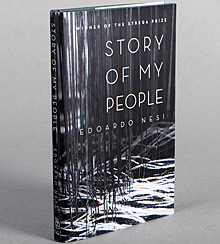Best Business Books 2013: Company Stories
Lessons in Failure
(originally published by Booz & Company)
Edoardo Nesi
Story of My People
(Other Press, 2013)
Steven G. Mandis
What Happened to Goldman Sachs: An Insider’s Story of Organizational Drift and Its Unintended Consequences
(Harvard Business Review Press, 2013)
David C. Robertson with Bill Breen
Brick by Brick: How Lego Rewrote the Rules of Innovation and Conquered the Global Toy Industry
(Crown Business, 2013)
Economist and systems scientist Kenneth Boulding once wrote, “Nothing fails like success because we don’t learn from it. We learn only from failure.” If that is the case, then the best business books relating company stories this year are packed with learning. Each one is a chronicle of failure in its own way: Edoardo Nesi’s Story of My People tells the tale of a family-owned company that failed because of its inability to adapt to a new reality; Steven Mandis’s What Happened to Goldman Sachs tells the story of a company that failed to live up to its values; and David Robertson and Bill Breen's Brick by Brick tells the story of a company that failed twice, but each time figured out how to recover.
A Failure to Adapt
We all know that globalization has disrupted industries around the world, but we don’t always connect disruption to the destruction of ways of life—the social fabric that globalization can rend and tear. Story of My People, by Edoardo Nesi, a polemic fueled by grief and rage at the devastating effect of globalization on the Italian textile industry, makes that connection tangible.
Nesi is the scion of a business family in the Tuscan town of Prato, which was a center for the design and manufacture of textiles for centuries. An award-winning writer, filmmaker, and translator, he knows the negative effects of globalization intimately: Nesi worked in and helped run his family’s textile business from 1993 to 2004, when he had no choice but to engineer the sale of the firm because it was no longer able to compete against lower-priced Chinese competitors.
With a literary mind and a flair for the visual, Nesi conjures up a vivid portrait of the fabric manufacturing company founded by his grandfather and granduncle, Lanificio T.O. Nesi & Figli SpA, and its long run of success in the fast-expanding economies of post–World War II Europe. It was a good time to be in business: Nesi recounts sales visits to Germany during which orders were written on the basis of relationships and price was rarely, if ever, discussed. This continued for three decades, during which time Prato became the center of a complex textile ecosystem, “insanely fragmented but incredibly efficient.”
No one profited more than Nesi’s family. He imagines familial ghosts taking their places at the empty tables around him, “drinking their martinis and their negronis and their camparis…miserably happy with all that they possess, their houses at [the seaside] and their Ferraris, their boats and their elegant clothing, their factories and their spectacular lovers.…” It reminds him of scenes written by F. Scott Fitzgerald. “If only novels and movies and paintings and poetry and opera and songs and even fashion—yes, even fashion—could ride to the rescue,” he writes, “preserving jobs and saving us all from a long, steady slide into, first, depression and ultimately poverty.”
There is, of course, no savior waiting in the wings, and Nesi’s grief over the loss of a way of life for his family, Prato, and, indeed, all of Italy turns to rage as he reflects on the causes of the economic catastrophe wrought by globalization. He shoulders part of the blame, admitting that the leaders of Prato’s textile industry mistakenly believed that they “could go on in the third millennium, selling the same fabrics…made out of the same raw materials and the same yarns, weaving them on the same looms, [dyeing] them the same colors…selling them to the usual customers in the usual markets,” never realizing that they were artisans, not industrialists, heirs to ancient traditions who had benefited from a once-in-a-lifetime opportunity.
However, he reserves the lion’s share of the blame for Italy’s technocrats, politicians, and economists, who spun tall tales of the infinite bounty of globalization and signed away the keys to the country. As it turned out, their reasoning that China’s markets would drive Italy’s economic growth was fatally flawed: The emerging Chinese middle class shows no sign of developing a taste for fashion “made in Italy.” Instead, Chinese apparel makers have knocked off the designs, copied the fabrics, and produced them in China for a fraction of the price. Yes, says Nesi, niche businesses with global brands, such as Ferrari and Armani, can still prosper. But their success can accommodate only a few people. “A country the size of Italy won’t fit.”
Prato’s textile industry is going to the Chinese, but not always leaving the city. Nesi points out that Prato now has the second-largest Chinese population in Italy, after Milan. In a city of 200,000 people, about 10,000 Chinese live legally and another 40,000 illegally. They work and sometimes live in about 3,500 businesses, often in squalor. “Even the most powerful words, the most elevated concepts seem to be emptied of meaning in the face of this horrendous story of indifference and exploitation among losers,” Nesi writes, “where all the characters are the victims of a chain of dishonesty that spreads out from a deeply rotten idea of work.”
What will happen next? Nesi has nightmares about an outbreak of ethnic violence between Italians and Chinese, but the story closes with a demonstration in Prato’s piazza, where he, along with thousands of others who have been displaced by globalization, carry a kilometer-long banner of Prato-made fabric. “I am not sure where we are going,” he says, “but we are certainly not standing still.”
A Failure of Values
Sometimes a firm fails even as it thrives financially. How this can come about is the theme of What Happened to Goldman Sachs: An Insider’s Story of Organizational Drift and Its Unintended Consequences, a biography of an organizational culture derived from the doctoral thesis of Steven G. Mandis, who is a Ph.D. candidate in the Department of Sociology at Columbia University and an adjunct associate professor in its business school. The book’s structure may be formal, but its content is fascinating and often reported firsthand. Mandis worked with and for some of the most senior people in Goldman Sachs’s investment banking, private equity, and proprietary trading units between 1992 and 2004, although he never made partner.
Mandis’s objective is to explain how and why the culture and values of Goldman Sachs changed, especially during the period when he was there, but also over the longer term, as the firm grew from a small group of New York–centric investment bankers into a large, global, diversified financial-services corporation. He begins at the memorial service for John L. Weinberg, whose death in 2006 severed the firm’s last close link with its founding values.
Weinberg had run the firm with John C. Whitehead from 1976 to 1984, and then as the sole senior partner until 1990. His father, Sidney J. Weinberg, had led Goldman from 1930 to 1969 and had embodied the essence of relationship banking. During this era Goldman Sachs’s distinctive values were lived every day, even though they were not codified until 1979, when Whitehead articulated them as 12 ethical principles. The firm was known for being “greedy, but not long-term greedy”—a catchphrase coined by a senior partner, epitomizing the firm’s orientation to sustained success for its clients and itself. Goldman was unique among the large firms on Wall Street for the care it lavished on its clients, and for its social network, which had been built on mutual trust and financial interdependence. Its selection and training of employees at all levels was the most rigorous and comprehensive in the industry.
Mandis describes how all this changed because of the constant competitive pressure, the demand for growth and profit, and the occasional crisis. For example, 1994’s hundreds of millions of dollars in trading losses quickened the transformation of Goldman Sachs’s culture, as it required partners to dip into their bank accounts to recapitalize the business. Many partners chose to retire, considered a selfish move among those who remained. Scores of new partners were appointed, and the power dynamics of the partnership were disrupted.
In the resulting turmoil, Jon Corzine, then an aggressive trader, demanded and got the title of CEO. He pushed for global expansion and argued for taking the firm public. Goldman Sachs became a limited liability company, a move that gave partners less skin in the game and made the firm more hierarchical, with an executive committee that wielded considerable power. According to Mandis, the collegial culture of the firm was significantly damaged during the 1990s, a process that continued as Corzine was forced out in a palace coup and replaced by Hank Paulson in 1998, and the firm went public in 1999.
The Goldman Sachs IPO made its partners fabulously wealthy. It also eliminated the need for them to supply investment capital and assume risk. Meanwhile, the entry of commercial banks into investment banking, and the rise of trading relative to investment banking within the firm, created a sea change in the business. Goldman’s clients were now more likely to be private equity firms and hedge funds than to be corporations and mutual funds. These new clients viewed Goldman Sachs as a counterparty to their trades, not as a trusted advisor. The core of the business shifted from relationships to transactions. The firm, says Mandis, was becoming short-term greedy.
Mandis does a meticulous job of teasing out the effects that the changes in Goldman Sachs’s business have had on its culture and values during the past 20 years. He argues that its financial success notwithstanding, Goldman Sachs failed as a moral enterprise. In making decisions today, he says, the firm is guided not by its values but rather by what its lawyers judge legal. For its sympathetic yet unflinching study of a firm and an industry that has come to epitomize what is problematic about Western capitalism, What Happened to Goldman Sachs is hard to beat.
Failing Forward
Most firms realize that they are failing only when their financial results collapse. By then, they are in deep trouble, and many are unable to learn from their mistakes and recover. In Brick by Brick: How Lego Rewrote the Rules of Innovation and Conquered the Global Toy Industry, David C. Robertson, practice professor at the Wharton School of the University of Pennsylvania, and Bill Breen, former Fast Company senior editor, tell the story of how Lego bucked the odds.
Robertson and Breen trace Lego’s rise from the decision of a carpenter to begin making wooden toys in the remote farming town of Billund, Denmark, in the 1930s to its current position as an iconic brand and a leader in the global toy industry. Unsurprisingly, the rise was not without its dips: By the mid-1990s, Lego had become a “heavy institution” that had lost its dynamism and sense of fun, according to the founder’s grandson, former company president Kjeld Kirk Kristiansen. Further, the growth potential of its portfolio of products was on the wane: The last of Lego’s patents had expired in the late 1980s and new technology was changing kids’ habits. When Lego’s leaders finally woke up, they were shocked to find themselves running an analog enterprise in a digital world.
In 1998, Lego hired a turnaround expert, Poul Plougmann, and offered him a hefty bonus to double sales by 2005. Plougmann tried to earn it by adopting a raft of innovation strategies. He set sail for “blue ocean” markets by introducing electronic educational toys under the Lego brand and, following the company’s success with Star Wars–branded products, partnered with Steven Spielberg to create a Lego movie studio. To become more customer driven and respond to current trends, the company even created, at Plougmann’s prodding, a completely new toy system without the ubiquitous plastic bricks and entered the hugely popular action figure market. Plougmann also started an ambitious project to digitize the Lego experience and offer kids the opportunity to build virtual structures. He tapped open innovation and heeded the wisdom of crowds by creating the Lego Digital Designer, which encouraged customers to design their own kits.
Plougmann and his lieutenants shook Lego out of its slumber, and rebuilt its culture around creativity and innovation. And then, four years later, in 2002, Lego experienced a disastrous sales slump in the critical Christmas season. In 2003, sales were 30 percent lower year over year and the company was US$800 million in debt. Annual cash flow was negative by $160 million, and the net loss was nearly double that figure. What had gone wrong? The short answer is that the volume and variety of innovations had overwhelmed the company’s capacity to handle change. The long answer makes up the rest of the book.
In early 2004, Kristiansen announced that Plougmann and his chief designer were out, and resumed leadership. He tapped 35-year-old Jorgen Vig Knudstorp, a fairly recent hire from McKinsey, to manage day-to-day operations. Knudstorp laid off 1,200 people and stanched the flow of red ink. Exploring the root causes of Lego’s problems, he realized that the frenetic pace of innovation had resulted in a proliferation of plastic parts that destroyed Lego’s economies of scale and cost discipline. Worse still, the company’s control systems were incapable of telling which products were profitable and which were not (94 percent were not). At the same time, Lego had lost its focus on the retailers that were its primary channel to consumers.
Knudstorp understood that Lego had to return to basics, stepping back before it could move ahead. One legacy of the undisciplined creativity of the Plougmann era provided Lego with the key insight and product line that would power a new way of thinking. The insight was that kids don’t just want to build things; they also want to tell compelling stories with the things they build. The product line was Bionicle, which married character assembly sets with an elaborate futuristic story line.
Bionicle, a portmanteau word derived from biological chronicle, was an artful combination of model building, storytelling, and adventure. Launched at the end of 2000, it was an immediate hit. Bionicle books and comics became bestsellers. Video games, clothing, lunch boxes, and backpacks followed. By 2003, the line was producing 25 percent of Lego’s revenues. “Bionicle is the toy that saved the Lego,” said Knudstorp.
The lessons in the Lego saga are many, but the bottom line is that although the desired outcomes of change (such as profitability and market share) are often generic, the hows are particular. Every organization has to find its own sequence and cadence. Poul Plougmann and his team got the coarse-grained headings on their action plans right, but their achievement depended on the deep, fine-grained appreciation of Lego’s culture and capabilities brought by Kristiansen, Knudstorp, and others.
Each of this year’s best business books relating company stories offers valuable lessons for leaders. For its evocative power and appreciation of all that is essential to life that cannot be measured in money, my Top Shelf selection is Story of My People, the first work of nonfiction to win Italy’s most prestigious literary award, the Strega Prize. In the ecology of Western capitalism, Prato is an edge community—one of those places where the future often appears first. Nesi’s tale is a valuable warning about how easy it is to sacrifice community on the altar of the marketplace.![]()
Author profile:
- David K. Hurst is a contributing editor of strategy+business and the author of several books, including most recently The New Ecology of Leadership: Business Mastery in a Chaotic World (Columbia Business School Publishing, 2012).





